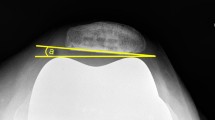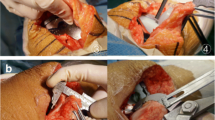Abstract
Purpose
Patellofemoral syndrome is still a common complication after total knee arthroplasty (TKA). However, the effects of specific surgical approaches on patellar tracking and alignment remain incompletely understood. In this study, we compared patellar alignment in patients who underwent TKA via three different techniques.
Methods
A total of 96 patients who completed a minimum follow-up of five years were involved in three groups: 30 patients were treated with the traditional medial parapatellar approach (MPP group), 35 patients were treated with the mini-medial parapatellar approach (MMP group) and 31 were treated with a quadriceps-sparing approach (QS group). Radiographic data for patellar alignment and clinical results were compared.
Results
Patellar tilt and patellar displacement at the final follow-up evaluation differed significantly among the three groups [P < 0.01, analysis of variance (ANOVA)]. The MMP and QS groups exhibited more proper patellar alignment than the MPP group. The clinical results did not differ significantly among the groups (P > 0.05, ANOVA). In addition, there were no correlations between postoperative patellar alignment and clinical scores.
Conclusions
The results of this study indicate that TKA performed using minimally invasive approaches yields superior patellar alignment compared to the traditional MPP approach.


Similar content being viewed by others
References
Sharkey PF, Hozack WJ, Rothman RH, Shastri S, Jacoby SM (2002) Insall Award paper. Why are total knee arthroplasties failing today? Clin Orthop Relat Res 404:7–13. doi:10.1097/01.blo.0000036002.13841.32
Baldini A, Anderson JA, Cerulli-Mariani P, Kalyvas J, Pavlov H, Sculco TP (2007) Patellofemoral evaluation after total knee arthroplasty. Validation of a new weight-bearing axial radiographic view. J Bone Joint Surg Am 89:1810–1817. doi:10.2106/JBJS.E.00432
Fukagawa S, Matsuda S, Mizu-uchi H, Miura H, Okazaki K, Iwamoto Y (2011) Changes in patellar alignment after total knee arthroplasty. Knee Surg Sports Traumatol Arthrosc 19:99–104. doi:10.1007/s00167-010-1164-7
Kong CG, Cho HM, Suhl KH, Kim MU, In Y (2012) Patellar tracking after total knee arthroplasty performed without lateral release. Knee 19:692–695. doi:10.1016/j.knee.2011.09.007
Meftah M, Jhurani A, Bhat JA, Ranawat AS, Ranawat CS (2012) The effect of patellar replacement technique on patellofemoral complications and anterior knee pain. J Arthroplasty 27:1075–1080. doi:10.1016/j.arth.2011.10.006
Kawano T, Miura H, Nagamine R, Urabe K, Matsuda S, Mawatari T, Moro-Oka T, Iwamoto Y (2002) Factors affecting patellar tracking after total knee arthroplasty. J Arthroplasty 17:942–947
Dhollander AAM, Bassens D, Victor J, Verdonk P (2013) Patellar tilt and thickness do not influence postoperative flexion in a high-flex design total knee arthroplasty. Knee Surg Sports Traumatol Arthrosc 21:2817–2822. doi:10.1007/s00167-012-2245-6
Lee GW, Lee SM, Jang SJ, Son JH (2013) The efficacy of patellar decompression for improving anterior knee pain following total knee arthroplasty without patellar resurfacing. Arch Orthop Trauma Surg 133:561–567. doi:10.1007/s00402-013-1702-0
Zha GC, Sun JY, Dong SJ (2014) Less anterior knee pain with a routine lateral release in total knee arthroplasty without patellar resurfacing: a prospective, randomized study. Knee Surg Sports Traumatol Arthrosc 22:517–525. doi:10.1007/s00167-013-2789-0
Chew JT, Stewart NJ, Hanssen AD, Luo ZP, Rand JA, An KN (1997) Differences in patellar tracking and knee kinematics among three different total knee designs. Clin Orthop Relat Res 345:87–98
Pongcharoen B, Yakampor T, Charoencholvanish K (2013) Patellar tracking and anterior knee pain are similar after medial parapatellar and midvastus approaches in minimally invasive TKA. Clin Orthop Relat Res 471:1654–1660. doi:10.1007/s11999-012-2778-5
Curtin B, Yakkanti M, Malkani A (2014) Postoperative pain and contracture following total knee arthroplasty comparing parapatellar and subvastus approaches. J Arthroplasty 29:33–36. doi:10.1016/j.arth.2013.03.021
Bindelglass DF, Vince KG (1996) Patellar tilt and subluxation following subvastus and parapatellar approach in total knee arthroplasty. Implication for surgical technique. J Arthroplasty 11:507–511
Varela-Egocheaga JR, Suárez-Suárez MA, Fernández-Villán M, González-Sastre V, Varela-Gómez JR, Rodríguez-Merchán C (2010) Minimally invasive subvastus approach: improving the results of total knee arthroplasty: a prospective, randomized trial. Clin Orthop Relat Res 468:1200–1208. doi:10.1007/s11999-009-1160-8
Heekin RD, Fokin AA (2013) Mini-midvastus versus mini-medial parapatellar approach for minimally invasive total knee arthroplasty: outcomes pendulum is at equilibrium. J Arthroplasty 29:339–342. doi:10.1016/j.arth.2013.05.016
Wülker N, Lambermont JP, Sacchetti L, Lazaró JG, Nardi J (2010) A prospective randomized study of minimally invasive total knee arthroplasty compared with conventional surgery. J Bone Joint Surg Am 92:1584–1590. doi:10.2106/JBJS.H.01070
Kim YH, Kim JS, Kim DY (2007) Clinical outcome and rate of complications after primary total knee replacement performed with quadriceps-sparing or standard arthrotomy. J Bone Joint Surg Br 89:467–470. doi:10.1302/0301-620x.89b4.18663
Lin SY, Chen CH, Fu YC, Huang PJ, Lu CC, Su JY, Chang JK, Huang HT (2013) Comparison of the clinical and radiological outcomes of three minimally invasive techniques for total knee replacement at two years. Bone Joint J 95-B:906–910. doi:10.1302/0301-620X.95B7.29694
Tria AJ Jr, Coon TM (2003) Minimal incision total knee arthroplasty: early experience. Clin Orthop Relat Res 416:185–190. doi:10.1097/01.blo.0000093030.56370.d9
Tenholder M, Clarke HD, Scuderi GR (2005) Minimal-incision total knee arthroplasty: the early clinical experience. Clin Orthop Relat Res 440:67–76
Insall J (1971) A midline approach to the knee. J Bone Joint Surg Am 53:1584–1586
Aglietti P, Baldini A, Sensi L (2006) Quadriceps-sparing versus mini-subvastus approach in total knee arthroplasty. Clin Orthop Relat Res 452:106–111. doi:10.1097/01.blo.0000238789.51972.16
Grelsamer RP, Bazos AN, Proctor CS (1993) Radiographic analysis of patellar tilt. J Bone Joint Surg Br 75:822–824
Laurin CA, Dussault R, Levesque HP (1979) The tangential x-ray investigation of the patellofemoral joint: x-ray technique, diagnostic criteria and their interpretation. Clin Orthop Relat Res 144:16–26
Petersen W, Rembitzki IV, Brüggemann GP, Ellermann A, Best R, Koppenburg AG, Liebau C (2014) Anterior knee pain after total knee arthroplasty: a narrative review. Int Orthop 38:319–328. doi:10.1007/s00264-013-2081-4
Schiavone Panni A, Cerciello S, Del Regno C, Felici A, Vasso M (2014) Patellar resurfacing complications in total knee arthroplasty. Int Orthop 38:313–317. doi:10.1007/s00264-013-2244-3
Bracey DN, Brown ML, Beard HR, Mannava S, Nazir OF, Seyler TM, Lang JE (2015) Effects of patellofemoral overstuffing on knee flexion and patellar kinematics following total knee arthroplasty: a cadaveric study. Int Orthop. doi:10.1007/s00264-015-2715-9
Župan A, Snoj Ž, Antolič V, Pompe B (2014) Better results with patelloplasty compared to traditional total knee arthroplasty. Int Orthop 38:1621–1625. doi:10.1007/s00264-014-2366-2
Matsueda M, Gustilo RB (2000) Subvastus and medial parapatellar approaches in total knee arthroplasty. Clin Orthop Relat Res 371:161–168
Ozkoc G, Hersekli MA, Akpinar S, Ozalay M, Uysal M, Cesur N, Tandogan RN (2005) Time dependent changes in patellar tracking with medial parapatellar and midvastus approaches. Knee Surg Sports Traumatol Arthrosc 13:654–657. doi:10.1007/s00167-004-0605-6
Scheurer P, Reininga IH, van Jonbergen HP, van Raay JJ (2015) Secondary patellar resurfacing following total knee arthroplasty: a cohort study in fifty eight knees with a mean follow-up of thirty one months. Int Orthop 39:1301–1306. doi:10.1007/s00264-015-2684-z
Bindelglass DF, Cohen JL, Dorr LD (1993) Patellar tilt and subluxation in total knee arthroplasty. Relationship to pain, fixation, and design. Clin Orthop Relat Res 286:103–109
Bertin KC, Lloyd WW (2013) Effect of total knee prosthesis design on patellar tracking and need for lateral retinacular release. J Arthroplasty 28:772–777. doi:10.1016/j.arth.2012.12.012
Breeman S, Campbell M, Dakin H, Fiddian N, Fitzpatrick R, Grant A, Gray A, Johnston L, Maclennan G, Morris R, Murray D, KAT Trial Group (2011) Patellar resurfacing in total knee replacement: five-year clinical and economic results of a large randomized controlled trial. J Bone Joint Surg Am 93:1473–1481. doi:10.2106/JBJS.J.00725
Smith AJ, Wood DJ, Li MG (2008) Total knee replacement with and without patellar resurfacing: a prospective, randomised trial using the profix total knee system. J Bone Joint Surg Br 90:43–49. doi:10.1302/0301-620X.90B1.18986
Acknowledgments
This study was funded by the Beijing Science and Technology Planning Projects of Beijing Science and Technology Committee (No. Z131100005213004), Instrument Research Project of the National Natural Science Foundation (No. 81327001). We thank Medjaden Bioscience for their language editing which greatly improved the manuscript.
Conflict of interest
The authors declare that they have no conflict of interest. No benefits in any form have been received or will be received from a commercial party related directly or indirectly to the subject of this article.
Author information
Authors and Affiliations
Corresponding author
Additional information
Ai-Bing Huang and Hai-Jun Wang contributed equally to this work.
Rights and permissions
About this article
Cite this article
Huang, AB., Wang, HJ., Yu, JK. et al. Optimal patellar alignment with minimally invasive approaches in total knee arthroplasty after a minimum five year follow-up. International Orthopaedics (SICOT) 40, 487–492 (2016). https://doi.org/10.1007/s00264-015-2896-2
Received:
Accepted:
Published:
Issue Date:
DOI: https://doi.org/10.1007/s00264-015-2896-2




